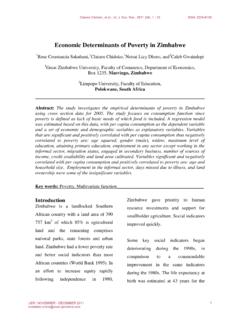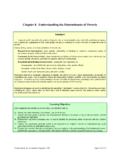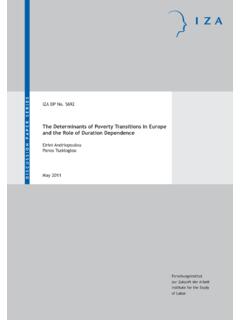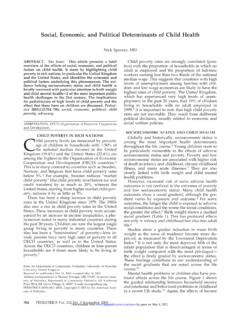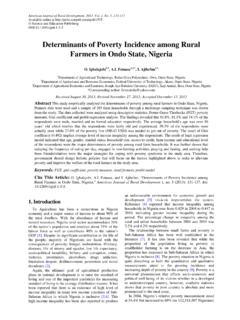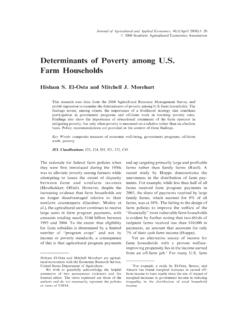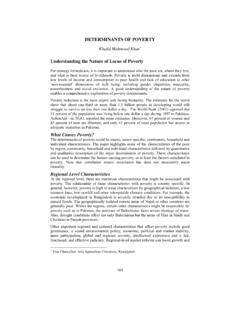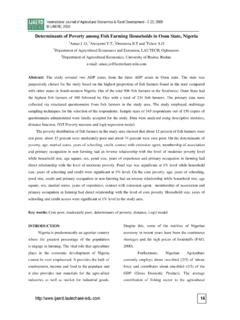Transcription of Profile and Determinants of Poverty in the Philippines
1 9th National Convention on Statistics (NCS) EDSA Shangri-La Hotel October 4-5, 2004 Profile and Determinants of Poverty in the Philippines by Jose Ramon G. Albert and Paula Monina Collado For additional information, please contact: Author s name: Jose Ramon G. Albert Paula Monina G. Collado Designation: Research Chief Deputy Administrator Agency: Statistical Research and Training Center Philippine National Statistics Office Address: Kalayaan Avenue, Quezon City Sta.
2 Mesa, Manila E-mail: Profile and Determinants of Poverty in the Philippines by Jose Ramon G. Albert and Paula Monina Collado ABSTRACT With the growing interest in reorienting economic development plans and policies toward developing resources for reducing Poverty , it is important to summarize information on Poverty in the Philippines and identify characteristics of the poor. A Poverty Profile serves this purpose and also acts as a descriptive tool for giving clues to the underlying Determinants of Poverty , which include economic, demographic, social and cultural factors.
3 Although Poverty profiles are insightful they are also limited by their informational content in the bivariate analysis. Here, we also consider a multivariate analysis of the Determinants of per capita income, the official measure of living standards in the Philippines . Using data from the 2000 Family Income and Expenditure Survey (FIES), conducted by the Philippine National Statistics Office (PNSO), we investigate with a regression model how a particular factor affects the Poverty situation conditional on the level of other potential Determinants of Poverty in the Philippines .
4 Then, we generate a simulation model for predicting reductions or increases in Poverty statistics that result from unit changes in selected aggregate household or community characteristics. The results described here can help further guide government policy formulation, especially in relation to Poverty reduction. I. Introduction Over the years, there has been considerable work on a descriptive analysis of Poverty in the Philippines (Intal, 1994; Marquez and Virola, 1995). Such interest in Poverty analysis has been further sharpened with the decision of a multitude of countries, including the Philippines , to sign the Millennium Declaration during the 2000 United Nations Summit and to work for achieving the Millennium Development Goals (MDGs).
5 One of the eight MDGs is the eradication of extreme Poverty and hunger, with two particular Poverty reduction targets: (a) to halve, between 1990 and 2015, the proportion of people whose income is less than one dollar a day; (b) to halve, between 1990 and 2015, the proportion of people who suffer from hunger. A number of indicators have been developed for monitoring progress in meeting the MDGs. This work complements the task of closely monitoring the economic and social situation in the country in order to analyze the impact, effectiveness, and efficiency of Poverty -oriented policies, programs, and projects.
6 The formulation of Poverty reduction policies, programs and projects ought to consider the available Poverty data. Major facts on Poverty sourced from the Family Income and Expenditure Survey (FIES), a household survey conducted by the Philippine National Statistics Office (PNSO) every three years, need to be Research Chief, Statistical Research & Training Center; President, Philippine Statistical Association; email: Deputy Administrator, Philippine National Statistics Office; email: described through tables and charts to show how Poverty varies across sub-groups of society.
7 This is known as a Poverty Profile . Although a Poverty Profile can be extremely informative and useful in assessing how patterns of economic change are likely to affect aggregate Poverty , it is limited by its bivariate content. It is also important to perform a multivariate analysis of the Determinants of per capita income, the official measure of living standards in the Philippines . This allows us to infer causality of specific household characteristics on household welfare and to perform a simulation on the extent at which Poverty may be reduced by making changes in some Poverty Determinants conditional on the level of other potential Determinants of Poverty .
8 A Poverty Profile , however, is an appropriate starting point for analyzing the Determinants of Poverty . In the next section, we briefly discuss the official Poverty measurement system in the Philippines . Subsequently, we develop a Poverty Profile and a regression model of per capita income based on household characteristics. II. Official Poverty Measurement There are essentially three steps to a Poverty measurement system, viz., (a) choosing a welfare indicator, (b) establishing a Poverty line, , a minimum acceptable standard of the welfare indicator that separates the poor from the non-poor, and (c) aggregating Poverty data (Ravallion, 1992; Deaton, 1997).
9 In the Philippines , the National Statistical Coordination Board (NSCB) is in charge of releasing the official Poverty statistics that are based on (per capita) income data sourced from the FIES. The FIES is a household survey conducted by the PNSO every three years currently having regions for its domains. Alternatives to the official methodology, which is currently under review by a Technical Committee on Poverty Statistics, have been espoused, , Balisacan (1999) and Kakwani (2000), that employ consumption data rather than income data. Official Poverty measurement actually started in 1985, but the measurement system has undergone a number of changes since then.
10 The latest changes in the official methodology involve the generation of Poverty lines for urban/rural areas of each province based on estimating per capita minimal food and non-food requirements in order to meet data users demands for more disaggregated statistics. Poverty lines were previously generated only up to the urban/rural areas of each region. The Food and Nutrition Research Institute (FNRI) constructs representative food menus for urban and rural areas of each region; these menus consider local consumption patterns and satisfying a minimum nutritional requirement of 2000 calories of energy and 50 grams of protein per person per day, as well as 80 percent sufficiency in daily intake of other nutrients and vitamins.
